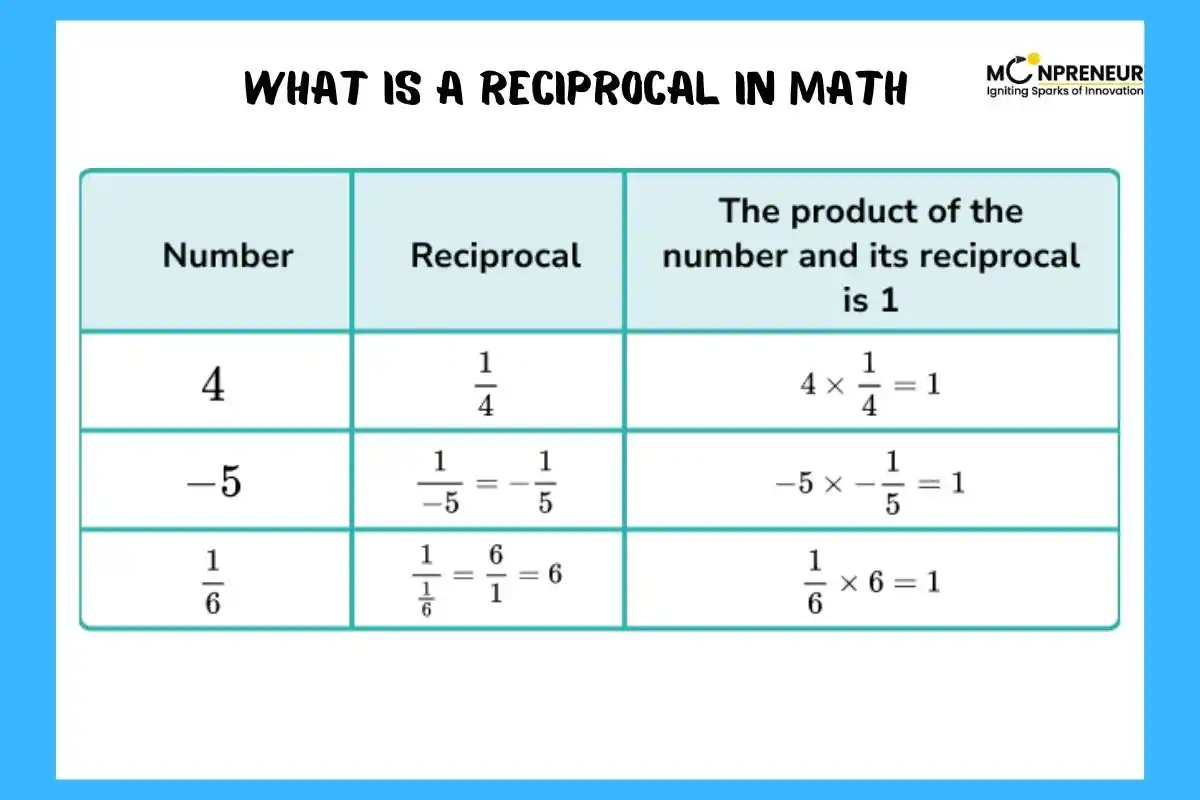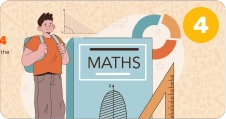In mathematics, a reciprocal is simply the inverse of a number or a value. If ‘n’ is a real number, then its reciprocal is expressed as 1/n. In other words, it is obtained by flipping the number. For instance, the reciprocal of 9 is written as 1/9. When a number is multiplied by its reciprocal, the result is always equal to 1. This property is also known as the multiplicative inverse.
Meaning of Reciprocal

The term ‘reciprocal’ is derived from the Latin word ‘reciprocus,’ which means ‘returning.’ This means that when we take the reciprocal of a reciprocal, we return to the original number. In this article, we will explore the definition of reciprocal, its properties, and how to find reciprocals of integers, fractions, decimals, and mixed numbers along with examples.
Table of Contents
In simple terms, the reciprocal of a number is 1 divided by that number. For any value \(\displaystyle a\), the reciprocal is written as \(\displaystyle \frac{1}{a}\). Multiplying a number by its reciprocal always results in \(\displaystyle 1\).
Example:
\(\displaystyle \text{Reciprocal of } 7 = \frac{1}{7}, \quad 7 \times \frac{1}{7} = 1\)
Other Definitions of Reciprocal
- Reciprocal is also called the multiplicative inverse.
- It can be thought of as flipping a number upside down.
- For fractions, it is obtained by interchanging numerator and denominator.
- Every non-zero number has a reciprocal.
- Reciprocal can also be expressed as \(\displaystyle x^{-1}\) for any number \(\displaystyle x\).
- Taking the reciprocal twice gives back the original number.
Reciprocal of Zero
Zero does not have a reciprocal because division by zero is undefined. Hence, every real number has a reciprocal except zero.
\(\displaystyle \text{For example, the reciprocal of } 5 \text{ is } \frac{1}{5}.\)
\(\displaystyle \text{For instance, the reciprocal of } -17 \text{ is } -\frac{1}{17}.\)
To find the reciprocal of a fraction, swap the numerator and denominator.
Example:
\(\displaystyle \text{Reciprocal of } \frac{2}{3} \text{ is } \frac{3}{2}\)
To find the reciprocal of a mixed fraction, first convert it into an improper fraction.
Example:
\(\displaystyle 4 \frac{1}{2} = \frac{9}{2}\)
\(\displaystyle \text{Its reciprocal is } \frac{2}{9}\)
The reciprocal of a decimal can be found by dividing 1 by the decimal or by converting it into a fraction.
Example:
\(\displaystyle 0.75 = \frac{3}{4}\)
\(\displaystyle \text{Its reciprocal is } \frac{4}{3}\)
When a number is multiplied by its reciprocal, the result is always 1 (unity).
Examples:
\(\displaystyle 2 \times \frac{1}{2} = 1\)
\(\displaystyle 10 \times \frac{1}{10} = 1\)
\(\displaystyle 100 \times \frac{1}{100} = 1\)
Reciprocals are very useful in division of fractions.
Example:
\(\displaystyle \left(\frac{2}{5}\right) \div \left(\frac{7}{5}\right) = \left(\frac{2}{5}\right) \times \left(\frac{5}{7}\right) = \frac{2}{7}\)
- \(\displaystyle \text{Reciprocal of } x \text{ is } \frac{1}{x}\)
- \(\displaystyle \text{Reciprocal of a fraction } \frac{x}{y} \text{ is } \frac{y}{x}\)
- \(\displaystyle \text{Reciprocal of } 2 \text{ is } \frac{1}{2}; \quad \text{reciprocal of } 9 \text{ is } \frac{1}{9}\)
- \(\displaystyle \text{Reciprocal of } \frac{3}{\frac{2}{3}} = \frac{9}{2}, \; \text{so reciprocal is } \frac{2}{9}\)
- \(\displaystyle \text{Reciprocal of } -\frac{5}{4} \text{ is } -\frac{4}{5}\)
- \(\displaystyle \text{Reciprocal of } 0.25 = \frac{1}{0.25} = 4\)
- \(\displaystyle \text{Reciprocal of } -45 \text{ is } -\frac{1}{45}\)
- Find the reciprocal of 29.
- \(\displaystyle \text{Find the reciprocal of } \frac{14}{15}\)
- \(\displaystyle \text{Find the reciprocal of } 1.25 \)
- \(\displaystyle \text{Find the reciprocal of } -80\)
- \(\displaystyle \text{Find the reciprocal of } ax^{2}\)
Conclusion
Reciprocals in math are a simple yet powerful concept that helps in solving equations, simplifying fractions, and understanding inverse relationships. By flipping a number or fraction upside down, you get its reciprocal, which when multiplied with the original number always equals 1. From fractions to decimals and even algebraic expressions, reciprocals play an important role in mathematics. Mastering this concept builds a strong foundation for higher-level math and everyday problem-solving.
Want to spark your child’s interest in math and boost their skills? Moonpreneur’s online math curriculum stands out because it engages kids with hands-on lessons, helps them apply math in real-life situations, and makes learning math exciting!
You can opt for our Advanced Math or Vedic Math+Mental Math courses. Our Math Quiz for grades 3rd, 4th, 5th, and 6th helps in further exciting and engaging in mathematics with hands-on lessons.
Ans: A reciprocal is the multiplicative inverse of a number. It is equal to 1 divided by that number.
Ans: \(\displaystyle \text{Interchange numerator and denominator. Example: Reciprocal of } \frac{3}{4} \text{ is } \frac{4}{3}.\)
Ans: \(\displaystyle \text{Convert to an improper fraction and then flip it. Example: } 2 \frac{3}{4} \;\to\; \frac{11}{4}, \;\text{reciprocal is } \frac{4}{11}.\)
Ans: No, zero does not have a reciprocal because division by zero is undefined.
Ans: \(\displaystyle \text{The reciprocal of infinity is } 0, \text{ since } \frac{1}{\infty} = 0.\)
Related Blogs:
How to Subtract Fractions: A Step-by-Step Guide for Beginners
How to Divide Fractions: Simple Steps, Examples & Practice Problems
How to Add Fractions – 3 Simple Steps
Factors of 36 – Prime Factorization, Factor Pairs, and Examples
What is 0.375 as a Fraction? Learn to Convert Decimal to Fraction Form
What is the Long Division Method? Step-by-Step Guide for Kids
What is 0.375 as a Fraction? Learn to Convert Decimal to Fraction Form
What is 12 Out of 16? Converting 12/16 to a Percentage for Kids
Convert 18 Out of 20 to Percentage – 90% Explained
Convert 4 Out of 7 to Percentage – Fast & Easy Math Help
Learn to convert 1.7 as a fraction easily.
13 out of 15 as a Percentage – Learn How to Convert Easily
What is 13.33% as a Fraction? | Simple Math Guide for Kids
How to Calculate 38 out of 50 as a Percentage – Easy Guide
Convert 0.16666666666 into a Fraction – Easy Math Guide
















